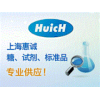      |

 通过认证 [诚信档案]
通过认证 [诚信档案]
| Cat. Number |
1516
|
| Chemical Name |
四唾液酸神经节苷脂GQ1b(NH4 +盐) Tetrasialoganglioside GQ1b (NH4+salt)
|
| CAS Number |
68652-37-9
|
| Mol. Formula |
C106H182N6O55•4NH3
|
| Mol. Weight |
2421 +4NH3
|
| Qty 1 |
100 µg
|
| Appearance |
solid
|
| Application Notes |
98+%,TLC; identity confirmed by MS
|
| Synonym |
GQ1b
|
| Solubility |
chloroform/methanol/water, 2:1:0.1; forms micellar solution in water
|
| Storage condition |
-20℃
|
| References |
Application Notes: Gangliosides1 are acidic glycosphingolipids that form lipid rafts in the outer leaflet of the cell plasma membrane, especially in neuronal cells in the central nervous system.2 They participate in cellular proliferation, differentiation, adhesion, signal transduction, cell-to-cell interactions, tumorigenesis, and metastasis.3 The accumulation of gangliosides has been linked to several diseases including Tay-Sachs and Sandhoff disease while an autoimmune response against gangliosides can lead to Guillain-Barré syndrome. Miller-Fisher syndrome, a variant of Guillain-Barré syndrome, is an autoimmune disease characterized by the presence of anti-GQ1b ganglioside antibodies. Studies of these antibodies reveal large disruptions of Schwann cells. GQ1b has been shown to enhance Ig production of human peripheral blood mononuclear cells and to selectively enhance Th1 cytokine production while suppressing Th2 production. GQ1b has also been shown to enhance PHAinduced IL-2 secretion of peripheral blood T cells while it decreases PHA-induced IL-4 and IL-5 secretion. GQ1b suppresses PHA-induced increases in cAMP levels in T cells and suppresses PHA-stimulated adenylate cyclase activity in T cells.4
References: |